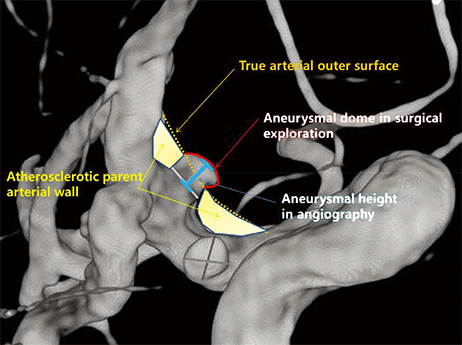J Cerebrovasc Endovasc Neurosurg.
2017 Mar;19(1):44-47. 10.7461/jcen.2017.19.1.44.
Discrepancy between Angiography and Operative Findings of Small Side Wall Aneurysms in Atherosclerotic Parent Arteries
- Affiliations
-
- 1Department of Neurosurgery, Inje University Seoul Paik Hospital, Seoul, Korea. lessordi@naver.com
- KMID: 2377625
- DOI: http://doi.org/10.7461/jcen.2017.19.1.44
Abstract
- Preoperative evaluation of precise aneurysmal geometry is important for the treatment of intracranial aneurysms. We present two cases of unclippable side wall aneurysms due to their extremely low dome height, which appeared as saccular in the preoperative image because of a comparatively narrow atherosclerotic parent arterial lumen. In both cases, a calcified vessel wall was noted preoperatively. Lack of a definitive neck and abrupt discrepancy between the fragile aneurysmal wall and the atherosclerotic parent arterial wall was confirmed intraoperatively in both cases. This study describes an illustrative mechanism for the finding with emphasis on the importance of its preoperative diagnosis. Intracranial atherosclerosis associated with small side walled aneurysms may lead to overestimation of aneurysm height on preoperative imaging of the intravascular compartment.
Keyword
MeSH Terms
Figure
Reference
-
1. Choi YJ, Jung SC, Lee DH. Vessel wall imaging of the intracranial and cervical carotid arteries. J Stroke. 2015; 09. 17(3):238–255.
Article2. Fifi JT, Komotar R, Meyers P, Khandji A, Tanji K, Connolly ES. Restricted diffusion in a thrombosed anterior cerebral artery aneurysm mimicking a dermoid cyst. J Neuroimaging. 2012; 01. 22(1):85–88.
Article3. Gounis MJ, van der Marel K, Marosfoi M, Mazzanti ML, Clarencon F, Chueh JY, et al. Imaging inflammation in cerebrovascular disease. Stroke. 2015; 10. 46(10):2991–2997.
Article4. Grigorian AA, Marcovici A, Flamm ES. Intraoperative factors associated with surgical outcome in patients with unruptured cerebral aneurysms: The experience of a single surgeon. J Neurosurg. 2003; 09. 99(3):452–457.
Article5. Jou LD, Mohamed A, Lee DH, Mawad ME. 3D rotational digital subtraction angiography may underestimate intracranial aneurysms: Findings from two basilar aneurysms. AJNR Am J Neuroradiol. 2007; 10. 28(9):1690–1692.
Article6. Kim JH, Cheong JH, Bak KH, Kim CH, Kim JM. Venous loop mimicking middle cerebral artery bifurcation aneurysm on computed tomographic angiography--case report. Surg Neurol. 2006; 11. 66(5):524–526.
Article7. Menke J, Larsen J, Kallenberg K. Diagnosing cerebral aneurysms by computed tomographic angiography: Meta-analysis. Ann Neurol. 2011; 04. 69(4):646–654.
Article8. Nagahata S, Nagahata M, Obara M, Kondo R, Minagawa N, Sato S, et al. Wall enhancement of the intracranial aneurysms revealed by magnetic resonance vessel wall imaging using three-dimensional turbo spin-echo sequence with motion-sensitized driven-equilibrium: A sign of ruptured aneurysm? Clin Neuroradiol. 2016; 09. 26(3):277–283.
Article9. Ohno K, Arai T, Isotani E, Nariai T, Hirakawa K. Ischaemic complication following obliteration of unruptured cerebral aneurysms with atherosclerotic or calcified neck. Acta Neurochir (Wien). 1999; 141(7):699–705. discussion 705-6.
Article10. Park CK, Shin HS, Choi SK, Lee SH, Koh JS. Clinical analysis and surgical considerations of atherosclerotic cerebral aneurysms: experience of a single center. J Cerebrovasc Endovasc Neurosurg. 2014; 09. 16(3):247–253.
Article
- Full Text Links
- Actions
-
Cited
- CITED
-
- Close
- Share
- Similar articles
-
- Internal Carotid Artery Aneurysms Arising Remote from Arterial Divisions: Dorsal and Medical ICAA
- Comparison of CT Angiography and Digital Subtraction Angiography in the Evaluation of Intracranial Aneurysmal Neck
- Technical Consideration of Carotid Ophthalmic Aneurysms Surgery, Horizontal Medialward Directing Aneurysms Under the Optic Nerve: Report of Two Operative Cases
- Parent Artery Complex Coil Protection for Side-Branched Wide-Neck Aneurysms
- Multiple Separate Aneurysms on Anterior Communicating Artery




